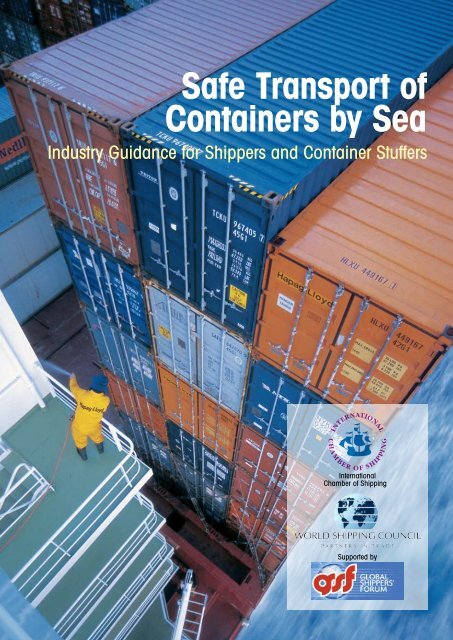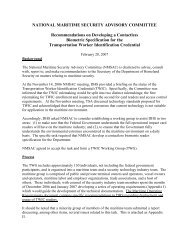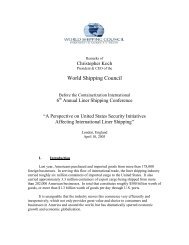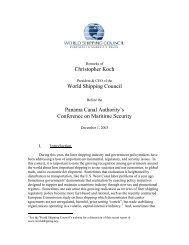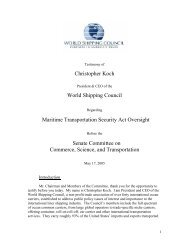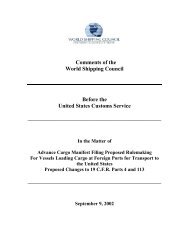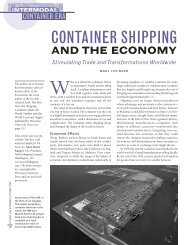Safe Transport of Containers by Sea - World Shipping Council
Safe Transport of Containers by Sea - World Shipping Council
Safe Transport of Containers by Sea - World Shipping Council
You also want an ePaper? Increase the reach of your titles
YUMPU automatically turns print PDFs into web optimized ePapers that Google loves.
<strong>Safe</strong> <strong>Transport</strong> <strong>of</strong><br />
<strong>Containers</strong> <strong>by</strong> <strong>Sea</strong><br />
Industry Guidance for Shippers and Container Stuffers<br />
International<br />
Chamber <strong>of</strong> <strong>Shipping</strong><br />
Supported <strong>by</strong>
In December 2008, the International<br />
Chamber <strong>of</strong> <strong>Shipping</strong> (ICS) and<br />
the <strong>World</strong> <strong>Shipping</strong> <strong>Council</strong> (WSC),<br />
published ‘<strong>Safe</strong> <strong>Transport</strong> <strong>of</strong><br />
<strong>Containers</strong> <strong>by</strong> <strong>Sea</strong>: Guidelines on<br />
Industry Best Practices’.<br />
The Guidelines have been produced<br />
to minimise the dangers to<br />
containerships, their crews, and all<br />
personnel involved with containers<br />
throughout the transport chain, and<br />
were developed <strong>by</strong> an expert industry<br />
working group, meeting in London<br />
and Washington DC during 2008.<br />
The Guidelines have now been<br />
presented to governments at IMO<br />
where they have been well received.<br />
Encouragingly, the Guidelines have<br />
also attracted a positive response<br />
from shippers’ organisations who,<br />
under the umbrella <strong>of</strong> the Global<br />
Shippers Forum (GSF), have lent their<br />
support to this brochure.<br />
The primary responsibility for the<br />
<strong>Safe</strong> <strong>Transport</strong> <strong>of</strong> <strong>Containers</strong> <strong>by</strong> <strong>Sea</strong><br />
safe transport <strong>of</strong> containers <strong>by</strong> sea<br />
rests with containership operators.<br />
However, there are many other parties<br />
in the transport chain concerned with<br />
the safe movement <strong>of</strong> containers.<br />
There are those employed <strong>by</strong> shipping<br />
lines involved with the booking<br />
and assignment <strong>of</strong> cargoes, and<br />
the subsequent arrangements for<br />
stowage planning; and there are the<br />
freight forwarders, ports and terminal<br />
operators and - particularly important<br />
- the shippers, from whom the cargo<br />
originates. All <strong>of</strong> these players have<br />
important responsibilities which are<br />
addressed <strong>by</strong> the Industry Guidelines.<br />
Particular emphasis is given <strong>by</strong> the<br />
Guidelines to the responsibilities<br />
<strong>of</strong> those involved with the correct<br />
packing, labelling and weighing<br />
<strong>of</strong> cargoes when they are stuffed<br />
into containers, and the accurate<br />
declaration <strong>of</strong> goods <strong>by</strong> cargo<br />
interests.<br />
All <strong>of</strong> these activities have a direct<br />
bearing on the safety <strong>of</strong> ships and the<br />
reduction <strong>of</strong> the risks to the lives <strong>of</strong><br />
ships’ crews and other personnel in<br />
the transport chain.<br />
The following advice is an extract<br />
from the main guidance on shippers’<br />
responsibilities addressed in the<br />
‘<strong>Safe</strong> <strong>Transport</strong> <strong>of</strong> <strong>Containers</strong> <strong>by</strong> <strong>Sea</strong>’<br />
guidelines.<br />
Comprehensive information on the<br />
safe stuffing and transport <strong>of</strong><br />
containers can be found in the<br />
joint International Chamber <strong>of</strong><br />
<strong>Shipping</strong> and <strong>World</strong> <strong>Shipping</strong><br />
<strong>Council</strong> publication<br />
‘<strong>Safe</strong> <strong>Transport</strong> <strong>of</strong> <strong>Containers</strong> <strong>by</strong><br />
<strong>Sea</strong>: Guidelines on Best Practices’.<br />
To order, see back page or contact<br />
your maritime bookseller.
1 Overview<br />
This guidance is addressed primarily to<br />
shippers, although everyone involved in the<br />
transport <strong>of</strong> containers <strong>by</strong> sea, not least<br />
ship operators and crew, should be aware <strong>of</strong><br />
the importance <strong>of</strong> stuffing containers safely<br />
and correctly, and the need to comply with<br />
international regulations and best practice<br />
procedures established <strong>by</strong> the industry. In<br />
the interests <strong>of</strong> protecting cargo, this is a<br />
matter <strong>of</strong> enlightened self interest.<br />
It is <strong>of</strong> the utmost importance to recognise<br />
that actions taken when containers are<br />
stuffed may have direct implications for the<br />
stability and safety <strong>of</strong> containerships, the<br />
lives <strong>of</strong> seafarers on board and the safety <strong>of</strong><br />
others throughout the transport chain.<br />
It is particularly important for all involved to<br />
understand the high degree <strong>of</strong> physical risk<br />
presented <strong>by</strong> the marine environment, the<br />
extreme forces to which a ship is exposed<br />
at sea, and the extent to which these risks<br />
are greatly increased <strong>by</strong> any failure to stuff<br />
containers correctly. This point cannot be<br />
over emphasised.<br />
It is vital to adhere to weight restrictions,<br />
and correct procedures for loading<br />
and securing cargo, to ensure the safe<br />
distribution <strong>of</strong> weight and that cargoes<br />
inside containers do not move or shift when<br />
at sea, compromising the safety <strong>of</strong> the ship.<br />
The IMO/ILO/UNECE Guidelines on the<br />
Packing <strong>of</strong> Cargo <strong>Transport</strong> Units provides a<br />
common global resource for information on<br />
container stuffing.<br />
2 Key Requirements<br />
Industry Guidance for Shippers and Container Stuffers<br />
The following requirements must be adhered<br />
to during container stuffing/unstuffing, in<br />
addition to the more specific observations<br />
elsewhere in this leaflet:<br />
• Subject to booking request, select the most<br />
suitable container type to accommodate the<br />
cargo;<br />
• Prepare a pre-stow plan before<br />
commencing stuffing so that weight/volume<br />
considerations are covered and point<br />
loading limits are observed;<br />
• Never load <strong>by</strong> weight above the payload<br />
limits <strong>of</strong> the container, i.e. the cargo and<br />
container net weight must not exceed the<br />
container’s gross safe working load;<br />
• Never load <strong>by</strong> weight above the road<br />
regulations applicable on the transit;<br />
• Distribute the weight <strong>of</strong> the cargo evenly<br />
over the floor <strong>of</strong> the container. Never stow<br />
heavy items in one section and light items<br />
in another. The weight <strong>of</strong> the cargo should<br />
not exceed the ’60% within half the length<br />
rule’;<br />
• Do not stow heavy goods on top <strong>of</strong> light<br />
goods;<br />
• Stow and secure all cargo tightly;<br />
• Observe all the handling instructions on<br />
cargo such as “Do not drop” or “This side up”;<br />
• Stow goods with sharp corners separate<br />
from other s<strong>of</strong>ter merchandise. Use dividers<br />
and separating material as appropriate;<br />
• Where possible with mixed loads, place<br />
packages containing liquid cargo on the<br />
bottom tiers with dry cargo on top;<br />
• Use cargo liners for obnoxious cargo such<br />
as hides and carbon black;<br />
• Do not use clamps or other loading<br />
devices unless the goods can withstand<br />
them;<br />
• When loading Dangerous Goods, ensure<br />
that the IMDG Code packaging requirements<br />
are always observed;<br />
• Do not load goods in a container with<br />
damaged packaging;<br />
• Do not stow wet and damp goods with dry<br />
goods;<br />
• Do not use dunnage or packaging which<br />
is incompatible with the cargo;<br />
• Do not stow goods with tainting odours<br />
with sensitive merchandise;<br />
• Observe all rules concerning dangerous<br />
cargo. Use appropriate labels and placards<br />
to identify packing and freight containers<br />
loaded with Dangerous Goods;<br />
• Stow hazardous cargo near the door<br />
where possible;<br />
• Include all necessary documentation;<br />
• Record the seal number and the container<br />
number on all shipping documents;<br />
• Never smoke, eat or drink during loading<br />
or unloading.<br />
3 Checking the Container<br />
In most operational regions, containers are<br />
inspected when they return after import but<br />
not again when they are released for export.<br />
There will also be instances <strong>of</strong> triangulation<br />
moves when the container is driven <strong>by</strong><br />
truck straight from the import customer to<br />
the export customer. In such cases, the<br />
container will probably have only received a<br />
quick sweep out and check for damage <strong>by</strong><br />
the haulier.<br />
A full container inspection for structural<br />
damage requires a competent and trained<br />
person. However, checking for cleanliness<br />
and general acceptability is a matter <strong>of</strong><br />
common sense. It is very much in the<br />
interests <strong>of</strong> any user, regardless <strong>of</strong> whether<br />
the container is being stuffed with a full load,<br />
to carry out a quick internal and external<br />
inspection prior to stuffing (and also after<br />
unstuffing the container).<br />
The following useful checklists should<br />
assist the examination <strong>of</strong> containers during<br />
cleaning, loading and unloading, to help<br />
minimise cargo damage and reduce risks<br />
to personnel. At all times, it is necessary to<br />
adhere to the IMO/ILO/UNECE Guidelines for<br />
Packing <strong>of</strong> Cargo <strong>Transport</strong> Units.<br />
3.1 Pre-Stuffing<br />
Prior to stuffing, a number <strong>of</strong> checks should
e made on a container both internally and<br />
externally to ensure that it is structurally<br />
sound, and safe to work in and around.<br />
Dated and digital photographs <strong>of</strong> the interior<br />
and exterior <strong>of</strong> the container should be taken.<br />
3.1.1 External Checks<br />
Before a container is opened, it should be<br />
ensured that it possesses a valid Container<br />
<strong>Safe</strong>ty Approval Plate and that the reexamination<br />
date has not passed. Once<br />
this has been established, the following<br />
aspects <strong>of</strong> the container’s exterior should be<br />
assessed before it is opened or entered:<br />
• Holes: No obvious holes or tears in the<br />
exterior panelling;<br />
• Doors: No broken or distorted door<br />
hinges, locks, or door seal gaskets;<br />
• Tilts (Tarps): Where containers are<br />
fitted with removable ro<strong>of</strong> tilts (tarps) or<br />
side curtains, they should fit correctly, be<br />
equipped with tilt wires and have no tears in<br />
the fabric;<br />
• Ro<strong>of</strong> bows: Open top containers should<br />
have all the ro<strong>of</strong> bows (supports) in place.<br />
If the ro<strong>of</strong> is <strong>of</strong> the retractable sort then the<br />
ro<strong>of</strong> bows should slide smoothly to the ends<br />
<strong>of</strong> the container;<br />
• Placards and Markings: Any placards or<br />
markings remaining on the outside <strong>of</strong> the<br />
empty container which refer to the previous<br />
cargo should be removed;<br />
• Structure: No serious structural defects<br />
such as torn or cracked corner fittings or<br />
side rails (IMO CSC/Circ. 134 contains<br />
guidance).<br />
3.1.2 Internal Checks<br />
Once the external elements <strong>of</strong> a container<br />
unit have been agreed to be <strong>of</strong> a suitable<br />
standard, the container may be opened in<br />
order that the following checks can be made:<br />
• Clean: No leftovers (sweepings, dust,<br />
grease or liquid) <strong>of</strong> the previous cargo;<br />
• Dry: The interior should be dry and free <strong>of</strong><br />
any sweat or frost;<br />
• No infestation: There should be no<br />
evidence <strong>of</strong> pests, insects or rodents which<br />
might contaminate cargo and lead to delay<br />
<strong>by</strong> port health authorities;<br />
• Taint free: If delicate goods susceptible<br />
to damage <strong>by</strong> bad odours are to be<br />
packed, then the container should be<br />
“sweet” smelling. This should be checked<br />
immediately on opening the doors when any<br />
lingering smells will be at their strongest.<br />
Caution must be exercised in case there<br />
are obnoxious gases from cargo previously<br />
stowed in containers, particularly where<br />
fumigation may have been used;<br />
• Watertight: This is best checked <strong>by</strong><br />
entering the container and closing both<br />
doors. If any spots <strong>of</strong> light can be seen<br />
then water can gain entry. This also applies<br />
to the container floor because water can<br />
splash upwards during road haulage;<br />
• Follow instructions: Any recommendations<br />
posted inside the container should be noted.<br />
3.2 Post Stuffing<br />
When the planned quantity <strong>of</strong> goods has<br />
been stuffed in a container, the following<br />
checks should be made:<br />
Restraint: The goods should be arranged<br />
and secured to withstand the normal stresses<br />
and strains <strong>of</strong> the journey. In particular,<br />
ensure doorway cargo cannot move;<br />
Customs inspection: If more than one type <strong>of</strong><br />
article is stuffed in the container, it may save<br />
time and the cost <strong>of</strong> a search if a sample <strong>of</strong><br />
each article is positioned near the door;<br />
Security: When the doors are shut, all<br />
securing lugs should be properly engaged<br />
forcing the door seals into compression.<br />
The company’s approved seal should be<br />
fitted in the appropriate position on the right<br />
hand door and the number noted. <strong>Sea</strong>ls<br />
should comply with ISO standards;<br />
Contents: Any placard, except those<br />
required <strong>by</strong> regulation, on the outside <strong>of</strong><br />
the container advertising the contents will<br />
attract thieves and should be removed. Any<br />
packages <strong>of</strong> Dangerous Goods should be<br />
labelled according to the IMDG Code;<br />
Placards: DG Placards, if appropriate,<br />
should be affixed in the recommended<br />
positions. The placards must be placed<br />
in such a way that they do not obscure<br />
the number <strong>of</strong> the container or other<br />
distinguishing marks.<br />
3.3 Prior to Unstuffing<br />
The following should be checked prior to<br />
unstuffing:<br />
Security: <strong>Sea</strong>l is intact and has not<br />
been tampered with. The number must<br />
be compared with the accompanying<br />
documents for possible future reference;<br />
External condition <strong>of</strong> the container: Any<br />
damage that may have affected the content<br />
should be duly noted;<br />
Placards and markings: Before opening the<br />
doors, due regard should be taken <strong>of</strong> any<br />
placards and markings such as DG labels<br />
or contents shipped in bulk;<br />
Doors: The doors should be opened<br />
cautiously and retaining straps attached<br />
to the locking bars to avoid harm to<br />
individuals. This is to guard against the<br />
risk <strong>of</strong> improperly secured cargo falling out<br />
and harming personnel. Once the doors<br />
are open, the container should be allowed<br />
to ‘air’ for a period <strong>of</strong> time to ensure that<br />
no hazardous gases or fumes are present<br />
which could affect persons entering it.<br />
3.4 Checklist after Unstuffing<br />
When a container is empty <strong>of</strong> cargo, the<br />
container should be checked for damage<br />
that might lead to claims. Most tariffs are so<br />
worded that it is obligatory for full container<br />
load customers to clean out the container<br />
after unstuffing. This includes removal <strong>of</strong> all<br />
packaging and a thorough sweep out.<br />
It is prudent to examine the container for<br />
any signs <strong>of</strong> wet stains and holes in the<br />
sides or ro<strong>of</strong> that might have affected the<br />
cargo which has just been carried. Labels<br />
and placards should be removed when the<br />
container is empty.<br />
4 General Stowage<br />
4.1 Homogeneous Cargo<br />
If the load consists <strong>of</strong> homogeneous cargo<br />
(and all the cargo is the same size) the total<br />
volume <strong>of</strong> the container should be utilised.<br />
Different kinds <strong>of</strong> packaging methods exist<br />
such as cartons, boxes, bags, drums and<br />
barrels, rolls, liners for liquid bulk and small<br />
wooden crates. The container may have<br />
vacant space left on completion <strong>of</strong> stuffing<br />
due to weight restrictions or otherwise, and<br />
sensible securing is necessary on grounds<br />
<strong>of</strong> safety and cargo care.<br />
Bagged cargoes with a high moisture<br />
content, such as cocoa beans or c<strong>of</strong>fee<br />
beans, may require dressing <strong>of</strong> the container<br />
ceiling and walls with moisture/condensation<br />
absorbing paper, and the hanging <strong>of</strong> so<br />
called Moisture Absorbing Materials (MAMS)<br />
bags in the container’s corners.<br />
4.2 Uniform Stowage<br />
When cargo is stowed into a container and<br />
free space is unavoidable, the cargo must<br />
be stowed in such a way that there is a gap<br />
in the middle <strong>of</strong> the stow. The gap, which<br />
can be fore and aft or athwart the container,<br />
must be chocked with wood or lashed with<br />
rope and, if the cargo is fragile, nets or<br />
dunnage bags must be used.<br />
4.3 Carton and Packages<br />
It is important to follow any instructions<br />
printed on the cartons, e.g. particular side<br />
up for bottles <strong>of</strong> wine which require corks to
emain immersed. To ensure stability in the<br />
stow and spread the weight as evenly as<br />
possible a “Bonded Block Stow” should be<br />
used.<br />
4.4 Bagged Cargo<br />
Bagged cargo tends to settle during transit<br />
causing pressure on side walls. Normal<br />
practice is to stow bags in interlocking<br />
stows. Bag on bag or building air chimneys<br />
within the stow may be necessary where<br />
extra ventilation is required.<br />
To avoid the risk <strong>of</strong> bags falling out <strong>of</strong> the<br />
container when the doors are opened, a<br />
brace or net should be placed against the<br />
final row. Bags that are stowed and secured<br />
on pallets do not cause this problem and<br />
the cargo can be handled much faster.<br />
4.5 Drums and Barrels<br />
Drums and barrels in containers should<br />
always be stowed upright if possible. If the<br />
bung or closure is at one end, then it should<br />
be stowed with the bung uppermost.<br />
Barrels <strong>of</strong> earthenware etc should always be<br />
stowed upright.<br />
Unless the drums or barrels are specially<br />
designed to “nest”, there should be some<br />
form <strong>of</strong> s<strong>of</strong>t dunnage or ply between each<br />
tier <strong>of</strong> drums. Dunnage should be laid<br />
sufficiently close to provide full support to<br />
the tier above.<br />
Rolling hoops, when pressed out <strong>of</strong> the<br />
side walls <strong>of</strong> the drums, are particularly<br />
susceptible to rupture through chafing. In<br />
some instances, it may be necessary to<br />
lay dunnage between individual drums<br />
to prevent rolling hoops from chafing one<br />
another. A second option is that each<br />
alternate row <strong>of</strong> drums may be lifted a few<br />
centimetres with carefully laid dunnage,<br />
allowing the rolling hoops to ride clear and<br />
reducing the effective diameter <strong>of</strong> each drum.<br />
Cargo behind the doorway should be<br />
properly secured with a fence, net or lashing.<br />
4.6 Rolls<br />
When rolls are stowed upright, they should<br />
be packed closely together. Any empty<br />
spaces between the rolls should be filled in<br />
<strong>by</strong> sacks <strong>of</strong> sawdust, corrugated cardboard<br />
or similar s<strong>of</strong>t dunnage. The rolls should be<br />
secured <strong>by</strong> means <strong>of</strong> timber, nets or wedges.<br />
When the rolls are stowed horizontally, the<br />
rolls which are nearest to the door should be<br />
secured <strong>by</strong> wedges or other similar devices.<br />
Support the rolls evenly along their length on<br />
a flat surface particularly with cargo such as<br />
carpets.<br />
Rolls <strong>of</strong> paper require paper clamps for<br />
careful handling.<br />
4.10 Reefer Cargoes<br />
Hot stuffing <strong>of</strong> containers (warm cargoes<br />
in cooled containers) should be avoided,<br />
and the cargoes should thus be pre-cooled.<br />
Reefer cargoes must be stowed in such a<br />
manner as to allow optimal circulation <strong>of</strong><br />
cold air. For example, stowage <strong>of</strong> cartons<br />
or other packages up to the container ceiling<br />
will prevent optimal air circulation and<br />
therefore optimal cooling.<br />
4.7 Bulk Liquids<br />
Wine, latex, printing ink and other nonhazardous<br />
liquids are <strong>of</strong>ten transported in<br />
strong synthetic “flexi-bags” in 20’ general<br />
dry containers. The bags must be braced at<br />
the door end <strong>of</strong> the container with a strong 5 <strong>Safe</strong>ty and Securing<br />
steel (or other material) bulkhead. This section identifies important issues <strong>of</strong><br />
It is important to make sure that the harness safety that have been experienced with<br />
straps on the bags are secured tightly to the containerised cargo and the related subject<br />
anchorage rings in the container. It is not<br />
only necessary to secure the load but also<br />
<strong>of</strong> cargo securing.<br />
to make sure the pressure on the walls is 5.1 Overloading<br />
not too high (if so, the pressure must be<br />
distributed with planks or plates).<br />
There have been many incidents over the<br />
years <strong>of</strong> containers being loaded above their<br />
<strong>Containers</strong> with corrugated side panels stipulated payload. This can seriously affect<br />
should be used. Bottom valves, if any, <strong>of</strong> stability and the safety <strong>of</strong> any ship carrying<br />
the flexi-bag must be enclosed and secured the cargo when it is underway at sea.<br />
<strong>by</strong> the bulkhead panel, to protect against<br />
shifting and bending during transport, which<br />
can tear the bag.<br />
In many cases the manifests declare<br />
cargo within payload limits when it is<br />
over the limit. This is <strong>of</strong>ten exposed <strong>by</strong><br />
4.8 Bulk Solids<br />
the suspicions <strong>of</strong> a container handler or<br />
even following an accident resulting in a<br />
Bulk bags are used for a wide range <strong>of</strong> weighbridge check.<br />
granular substances including malt and<br />
c<strong>of</strong>fee. Care should be taken to ensure<br />
that the cargo does not exceed the design<br />
parameters <strong>of</strong> the container.<br />
Overloading is something which can NEVER<br />
be condoned and when accepting cargo<br />
the following should always be obtained or<br />
checked. The party stuffing the container is<br />
responsible for ensuring that:<br />
4.9 Hanging Garments<br />
• The number <strong>of</strong> pieces, size, weight and<br />
Specialist containers are available for volume <strong>of</strong> any commodity is obtained;<br />
shipping clothing. Failure to observe<br />
proper preparation and stowage procedures<br />
can result in considerable claims for dry<br />
cleaning <strong>of</strong> garments which may have<br />
dropped to the container floor.<br />
• The payload and volume <strong>of</strong> the container<br />
selected/requested is compared with the<br />
cargo particulars to establish whether a<br />
weight or volume restriction applies;<br />
• The gross mass <strong>of</strong> the container is in<br />
accordance with the gross mass given on<br />
the shipping documents.<br />
Where a weight restriction applies, the point
loading <strong>of</strong> cargo must also be checked<br />
in order that the tonnes per square metre<br />
loading limit is not breached. Cargoes such<br />
as metal ingots come into this category and<br />
timber <strong>of</strong>ten requires the weight to be spread.<br />
Extremely dense cargo can overload a<br />
small area <strong>of</strong> a container’s floor causing it<br />
to fail. For extremely dense cargo, or cargo<br />
that puts a high load into a small area <strong>of</strong> a<br />
container’s floor, timber or other dunnage<br />
must be used to spread the weight over a<br />
larger floor area.<br />
As a rule <strong>of</strong> thumb, floor loading should<br />
not exceed 2,500 lb per linear foot <strong>of</strong> the<br />
container or a maximum <strong>of</strong> 1.5 tonnes per<br />
floor supporting cross member.<br />
5.3 DG<br />
In the interests <strong>of</strong> safety, it is essential to<br />
ensure the following with respect to the<br />
stowage <strong>of</strong> Dangerous Goods within a<br />
container:<br />
• The cargo must be declared to the<br />
appropriate dangerous cargo department;<br />
• All documentation must be completed,<br />
signed and accurate;<br />
• Individual packages <strong>of</strong> DG must be<br />
labelled;<br />
• The container must be properly placarded<br />
with appropriate placards, marks and signs,<br />
as determined <strong>by</strong> the IMDG Code, affixed<br />
to the outside walls <strong>of</strong> the container as<br />
specified <strong>by</strong> the Code;<br />
• The relevant IMDG stowage segregation<br />
requirements must be complied with at all<br />
times.<br />
5.4 Shifting Cargo<br />
The incidence <strong>of</strong> cargo moving inside a<br />
container during transit is considerable.<br />
This is usually because the cargo has not<br />
been secured properly, or the packaging is<br />
defective. Apart from the serious risks to<br />
ships and the stability <strong>of</strong> container stacks,<br />
several cases have been recorded where<br />
road vehicles have turned over due to cargo<br />
moving, when negotiating bends. The key<br />
issue is to secure cargo efficiently to prevent<br />
the initial movement.<br />
Although containerised cargo is well<br />
protected, it is still subject to the constant<br />
movement and stress <strong>of</strong> maritime transport.<br />
In heavy seas, the cargo is exposed to<br />
compressive forces due to pitching and<br />
rolling. These forces may increase the<br />
normal strain on lashings, struts and other<br />
securing devices <strong>by</strong> as much as 100%.<br />
Effective securing <strong>of</strong> the load throughout<br />
the entire transport process is therefore <strong>of</strong><br />
absolute importance.<br />
Example for a typical 20’ container’s lashing<br />
facilities:<br />
No <strong>of</strong> Rating<br />
lashing<br />
Location points kg<br />
Side wall (base) 5 2,000<br />
Side wall (top) 5 500<br />
Front (base) 1 500<br />
Rear (door recess area) 5 500<br />
It should be noted that the walls, doors and<br />
ro<strong>of</strong> <strong>of</strong> a container are merely a protective<br />
shell that cannot withstand concentrated<br />
stress. If the walls or ceiling are used for<br />
lashing purposes, the stress on the walls or<br />
ceiling must be evenly distributed.<br />
5.5.1 Securing Materials<br />
Most types <strong>of</strong> cargo can be secured using<br />
the following materials (though precautions<br />
should be taken to ensure that they are not<br />
forbidden for import into the cargo’s country<br />
<strong>of</strong> destination):<br />
• Timber beams, struts, chocks, planks for<br />
shoring, bracing and relieving pressure;<br />
• Adjustable wooden battens, rods<br />
or strap belts for securing the load<br />
in sections, facilitating mechanical<br />
discharge;<br />
• Plywood and dunnage to separate<br />
several layers <strong>of</strong> cargo or to<br />
segregate different types <strong>of</strong> cargo<br />
into separate sections;<br />
• Foam-rubber cushions and air<br />
bags to reduce vibration and prevent<br />
the load from shifting;<br />
5.5 Securing in <strong>Containers</strong><br />
• Second hand tyres or bags with<br />
The cargo in containers needs to be stowed<br />
in such a way that the cargo cannot move.<br />
The container itself is designed to permit<br />
paper waste or sawdust to fill empty<br />
spaces, s<strong>of</strong>ten the impact and<br />
prevent shifting;<br />
tight, secure stowage <strong>of</strong> cargo either through • Nets to secure fragile goods;<br />
5.2 Road and Rail Limits<br />
Apart from the immediate dangers to the safety<br />
<strong>of</strong> ships created <strong>by</strong> overloading, the gross<br />
weight <strong>of</strong> the container (cargo plus container<br />
tare) must not breach the applicable road or<br />
rail limits on all legs <strong>of</strong> the transit journey.<br />
The importance <strong>of</strong> observing these limits<br />
cannot be overstressed.<br />
compact loading or individual securing.<br />
These facilities include:<br />
• Floor <strong>of</strong> wood or plywood which permits<br />
blocks, stays and wedges to be anchored<br />
with nails or screws;<br />
• Internal walls, for the support <strong>of</strong> light<br />
cargo only;<br />
• Corner posts which are suitable for<br />
• Rope (hemp, manila, sisal, etc),<br />
wire, steel bands and terylene straps<br />
for lashing;<br />
• Nylon span sets;<br />
• Bolt clips into T section flooring in<br />
insulated containers;<br />
• Bulkhead bars.<br />
bracing to with timbers and <strong>by</strong> using lashing<br />
points provided inside the container; 5.5.2 Securing calculations aboard<br />
ship:<br />
• Lashing points are located along top<br />
and bottom rails <strong>of</strong> the container at regular<br />
intervals.<br />
As shown in Figure 1, forces acting<br />
in a seaway are:<br />
Rotational:<br />
Rolling;<br />
Pitching;<br />
Sheering/Yawing.<br />
Linear:<br />
Swaying;<br />
Surging;<br />
Heaving.<br />
Calculations for securing against<br />
the above forces follow a prescribed<br />
discipline and it is important to refer<br />
to this procedure when performing<br />
calculations. The recognised<br />
calculations are contained in the<br />
IMO Code <strong>of</strong> <strong>Safe</strong> Practice for Cargo<br />
Stowage and Securing (CSS Code).<br />
6.6 Final Weighing <strong>of</strong> Container<br />
After finalisation <strong>of</strong> stuffing and<br />
securing <strong>of</strong> containerised cargo,<br />
the total container weight must be<br />
verified and documented.
Ship Motions in a Heavy <strong>Sea</strong>way<br />
Rotational Linear<br />
Roll Sway<br />
40° 40°<br />
Pitch<br />
10° 10°<br />
5° 5°<br />
Surge<br />
Yaw Heave<br />
Momentary<br />
deflection<br />
from projected<br />
course<br />
Brief sideways motion along slope <strong>of</strong> sea surface<br />
Brief additional forward motion due to rise and fall<br />
<strong>of</strong> sea surface<br />
Brief vertical motion due to rise and fall <strong>of</strong> sea surface
Please photocopy and send this form whenever you wish to order a publication.<br />
Marisec Publications Order Form<br />
All publications, should be ordered <strong>by</strong> sending this<br />
form to:<br />
Marisec Publications<br />
12 Carthusian Street, London, EC1M 6EZ<br />
Tel +44 20 7417 2855/8844<br />
Fax +44 20 7417 8877<br />
E-mail publications@marisec.org<br />
www.marisec.org<br />
Date <strong>of</strong> order Order No.<br />
Invoice to Deliver to (if different from the invoice address)<br />
Telephone Fax<br />
E-Mail<br />
Publication Title Unit Price (£) Quantity Order Price (£)<br />
<strong>Safe</strong> <strong>Transport</strong> <strong>of</strong> <strong>Containers</strong> <strong>by</strong> <strong>Sea</strong> £80<br />
Total (minus bulk order discount if applicable) £<br />
Payment Details<br />
Marisec Publications require pre-payment on all publication orders.<br />
Please arrange payment <strong>by</strong> one <strong>of</strong> the following methods:<br />
Bank transfer (details will be forwarded on receipt <strong>of</strong> order)<br />
Cheque enclosed for £<br />
Cheques should be expressed in Pounds Sterling, drawn on a bank in the UK<br />
and made payable to ‘Marisec Publications’<br />
Please debit my Maestro/Visa/Mastercard/Amex for £<br />
Name <strong>of</strong> Cardholder Signature Date<br />
Address <strong>of</strong> Cardholder (if different from the invoice address)<br />
Card Number<br />
Start Date<br />
/<br />
Expiry Date /<br />
Issue No. (Maestro only)<br />
Bulk Order Discounts<br />
20% discount for orders <strong>of</strong> 50 or more copies<br />
<strong>of</strong> the same publication or for any order<br />
exceeding £750.*<br />
30% discount for orders <strong>of</strong> 100 or more<br />
copies <strong>of</strong> the same publication.*<br />
Security Code<br />
Remember, prices for products ordered direct from Marisec Publications include worldwide airmail postage**<br />
* Bulk order discount excludes ICS Tanker Guides (Chemicals and Liquefied Gas), ISF/Marlins products, ISF Watchkeeper s<strong>of</strong>tware, Personal Training and Service Record<br />
Books, and On Board Training Record Books, for which special prices already apply. ** Free postage excludes Tanker <strong>Safe</strong>ty Guide (Chemicals) and Tanker <strong>Safe</strong>ty Guide<br />
(Liquefied Gas).


